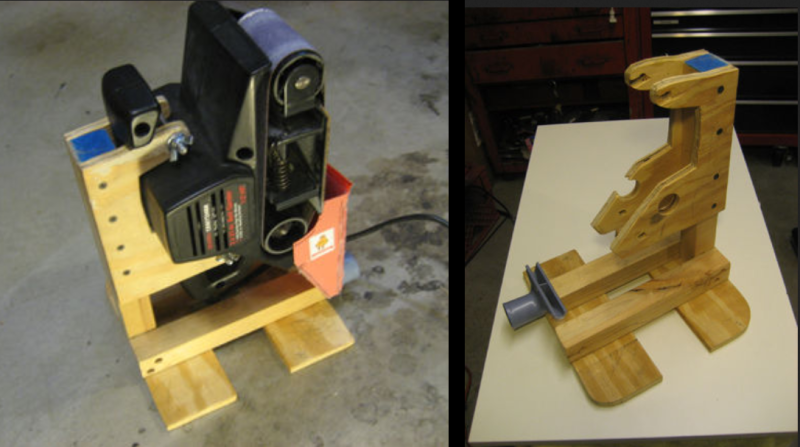Having a basement or garage shop sure comes in useful for the home handyman. One downside to having a self-funded show is that you may not have every tool that you need. [unknownuser2007] had a hand-held belt sander and regularly used it to round off sharp corners on small parts instead of using it for its intended purpose; smoothing out long flat boards. It was typical for [unknownuser2007] to hold the sander in one hand and his work in the other while sanding his wooden parts.
This method of sanding was not very precise (or safe) so he decided it was time to do something about it and build a stand for the sander. The frame is built from 1/2 inch plywood, with pieces jig-sawn to fit the contour of the belt sander housing. After the frame was assembled, a dust collection system was made using an old vacuum attachment and some plastic sheet. The finished rig mounts solidly to the work bench and now allows [unknownuser2007] to use both hands to shape his creations.
As much as we love these types useful tool mods, on revision 2 we’d like to see an easily accessible on/off switch and a work support square to the belt. If you’re interested in more DIY sander solutions, check out this 20 inch disk sander.
















The power switch is very accessible, it is a foot switch! Walk up with both hands holding part and hands free… the power is on. I would add variable speed. Belt sanders haven’t caught up with drills yet. Single speed is too retro.
Nice stand, I love seeing tools and basic raw materials used to improve other tools. Technically when you turn a belt sander upside down, it becomes a linisher. And they are truly one of the handiest power tools around, especially so if it has a table and sliding fence to get accurate 90 degree faces.
Safety-wise, the foot switch idea could be improved – can you make a pivoting bar which knocks the switch out? Or, bring the power plug up to the bench surface and use a switched wall socket in a box.
When I was a kid we were fortunate enough to have a large metal lathe. It had push-button switches but my forever safety-conscious dad made a drop-out safety switch for it which consisted of a steel rod that ran all along the front of the lathe stand that had offset pivots on each end, and a microswitch. When knocked upward with the knee or hand, the microswitch dropped out a sealed-in relay and the mains power cut off instantly.
I used it a few times, too, when things went wrong!
It’s a hand sander – there’s no safety switch when using it normally…not sure why simply putting it in a stand would warrant any additional effort, but if you were going to do it, a spring loaded ‘on’ switch seems safer – push down to make contact, if you are no longer pushing, the spring returns to the off position automatically.
Additionally, glad to see a project made from wood that didn’t involve a laser cutter – seems people don’t think things can be made with jigsaws or heaven forbid, non-electric tools anymore.
Very classy. Would make a nice accompaniment to the drill lathe: http://hackaday.com/2014/06/19/clever-re-purposing-of-a-power-drill-results-in-a-mini-wood-lathe/
Excellent. I have done one of these for my variable speed B&D belt sander. I went with the total inversion option; the belt runs left to right. Dust collection is a bit of a problem, but I am now inspires to improve that.
Note to self: Do a HackADay on my workshop dust collection contraption.
My dad has a horizontal version, also made of wood, with a surface all around the machine, locking it in place without any fasteners and providing a much larger work-surface, perpendicular to the machine. The machine is always stored in this stand, the cord spools around the stand, between the bottom surface and the working surface. The bottom plate is usually clamped to a workbench to keep it in place. It has been in use for as long as I can remember, and I’m 37….
So get the Hero Zero Donuts hack now and shock you buddies along
with your a lot better Hero which shall be extra strong and can have
higher merchandise.
7 year old project, and probably covered by HaD back then, but be honest, who keeps track of such things for 7 years? So I think it’s good enough to remind us of, or remind ‘newcomers’.